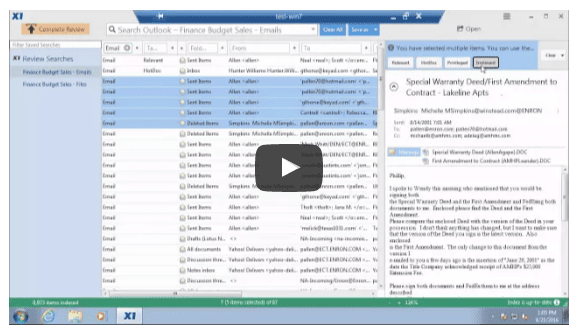eDiscovery collection and preservation efforts are often costly, time consuming and burdensome. Even worse, courts continue to routinely dish out punitive sanctions for ESI preservation failures. The volume of Electronically Stored Information is growing exponentially and will only continue to do so. Even with the advent of predictive coding, the costs associated with collecting, processing, reviewing, and producing documents in litigation are the source of considerable pain for litigants. The only way to reduce that pain to its minimum is to use all tools available in all appropriate circumstances within the bounds of reasonableness and proportionality to control the volumes of data that enter the discovery pipeline.
Counsel for large enterprises embroiled in litigation often gravitate to custodian self-collection, as it is a method to limit ESI preservation to only a limited set of documents and email deemed responsive by the individual custodians to the parameters of the litigation hold. However, traditional custodian self-collection is fraught with risk as it is usually not performed in a systemized or defensible manner. Various custodians are not employing uniform search criteria and methodology across the same case. Corporate counsel who rely on self-collection lack confidence in the accuracy and thoroughness of the process. Further, an average employee has neither the legal nor the technical expertise needed to identify and/or acquire potentially relevant ESI for purposes of litigation.
In a recent case that dramatically illustrates the perils of custodian self-collection, a company found themselves on the wrong end of a $3 million sanctions penalty for spoliation of evidence. The case illustrates that establishing a litigation hold and notifying the custodians is just the first step. Effective monitoring and compliance with the litigation hold is essential to avoid punitive sanctions. GN Netcom, Inc. v. Plantronics, Inc., No. 12-1318-LPS, 2016 U.S. Dist. LEXIS 93299 (D. Del. July 12, 2016).
In GN Netcom, Plantronics promptly issued a litigation hold, conducted training sessions, and sent quarterly reminders to custodians requiring affirmative acknowledgment of compliance with the hold. Despite these efforts, a senior Plantronics executive deleted relevant emails and asked his subordinates to follow suit. The court ultimately found that Plantronics acted in bad faith, “intend[ing] to impair the ability of the other side to effectively litigate its case.” In addition to the $3 million monetary penalty, Plantronics also faces severe evidentiary sanctions at trial.
At the other end of the spectrum, full disk image collection is another preservation option that, while being defensible, is very costly, burdensome and disruptive to operations. Recently in this blog, I discussed at length the numerous challenges associated with full disk imaging.
Litigators and commentators often pine for the advent of a systemized, uniform and defensible process for custodian self-collection. Conceptually, such an ideal process would be where custodians are automatically presented with a set of their documents and emails that are identified as potentially relevant to a given matter though a set of keywords and other search parameters that are uniformly applied across all custodians. This set of ESI would be presented to the custodian in a controlled interface with no ability to delete documents or emails, and only the ability to review and apply tags. The custodian would have to comply with the order and all documents responsive to the initial unified search would be collected as a default control mechanism.
With X1 Distributed Discovery (X1DD), the option for a defensible custodian assisted review is now a reality. At a high level, with X1DD, organizations can perform targeted search and collection of the ESI of thousands of endpoints over the internal network without disrupting operations. The search results are returned in minutes, not weeks, and thus can be highly granular and iterative, based upon multiple keywords, date ranges, file types, or other parameters. This approach typically reduces the eDiscovery collection and processing costs by at least one order of magnitude (90%), thereby bringing much needed feasibility to enterprise-wide eDiscovery collection that can save organizations millions while improving compliance.
As a key optional feature, X1DD provides custodian assisted review, where custodians are presented with a listing of their potentially relevant ESI though a controlled, systemized and uniform identification process for their review and tagging. Instead of essentially asking the custodians to “please rummage through your entire email account and all your documents to look for what you might think is relevant to this matter,” the custodians are presented with a narrow and organized subset of potentially relevant ESI for their review. While the custodians are able to assist with the review, they cannot impact or control what ESI is identified and preserved; this is controlled and managed centrally by the eDiscovery practitioner. This way, custodians can apply their own insight to the information, flag personal private data, all while effectuating very cost-effective and systematic ESI collection.
The process is very defensible as the exercise is logged and documented, with all metadata kept intact and a concise chain of custody established. I could describe this very important feature a lot further, but candidly the best way to get a full picture is to see it for yourself. I recommend that you view this recorded 9 minute demonstration of X1 Distributed Discovery’s custodian self-review feature here.
We believe X1DD’s functionality provides the optimal means for enterprise eDiscovery preservation, collection and early data assessment, especially with the key additional (and optional) feature of custodian assisted review. But please see for yourself and let us know what you think!

